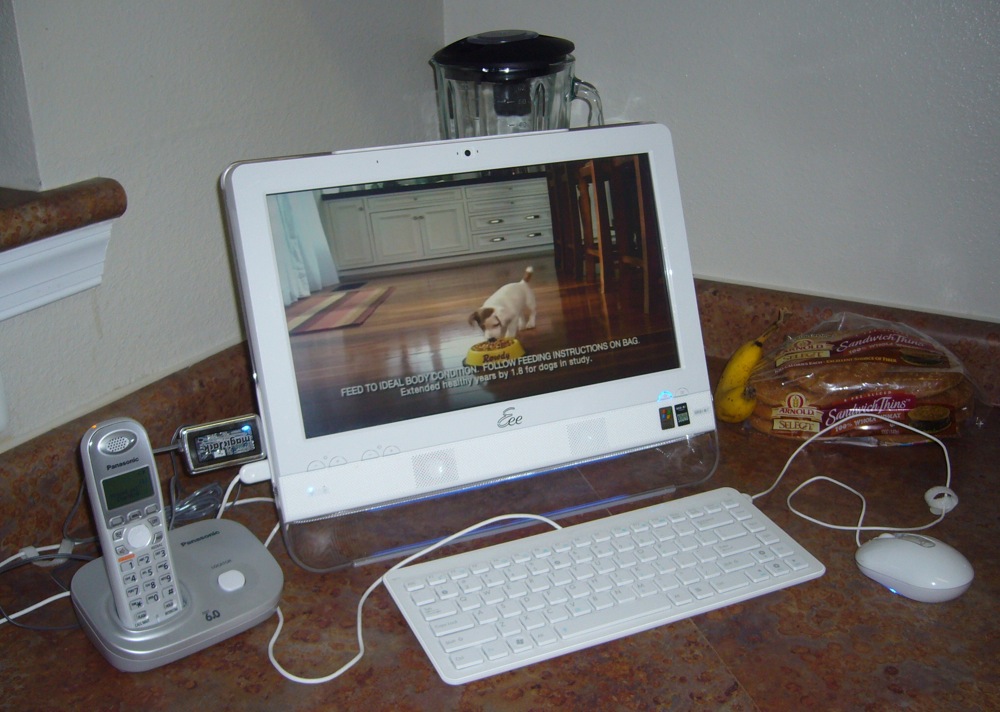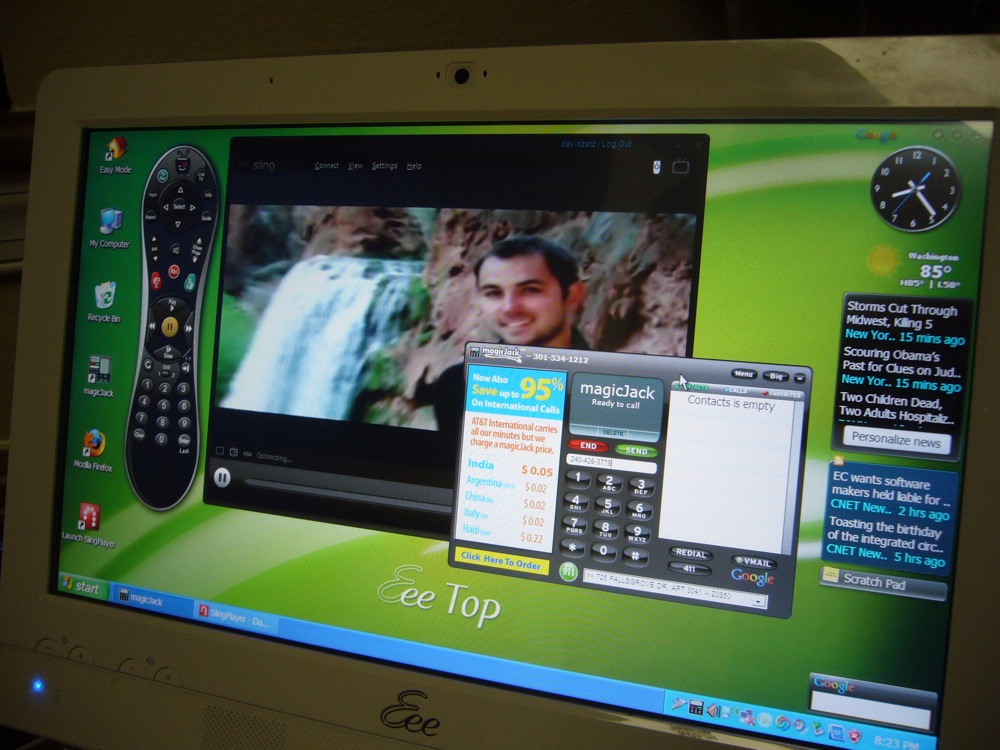
My initial impression of the Verizon Hub wasn’t entirely positive – I’d rather have a touchscreen Eee Top in my kitchen. –DZ, 02/09
Given my pre-release proclamation above and after catching Brad Linder’s (Lilliputing) ASUS Eee Top ETP1602 review, I had to get my hands on a unit. Fortunately, Brad (and ASUS) were quite accommodating and I’ve been playing with his very same review loaner the last couple weeks. Whereas Brad dropped the Eee Top (~$500) in his office, being a fan (conceptually) of the Audrey and Icebox computing appliances of lore, I placed the 15.6″ all-in-one PC in our kitchen. Where I believe it belongs.
First off, while definitely plasticy, the Eee looks pretty sharp. Minus the cable clutter. My phone related paraphernalia could easily be cleaned up, but I positioned it front and center (well, off to the left) to demonstrate connectivity. Unfortunately, the wired keyboard and mouse would require an additional investment to free yourself of cables. In fact, if we’re counting pennies, I’d prefer ASUS provide wireless interfaces over the touchscreen – which I found myself rarely using. (Perhaps compounded by the review unit not shipping with its bundled stylus.) I appreciated the volume and brightness controls located on the bezel, in addition to the screen blanking button. And the Eee Top rear, which Brad photographed, features a simple yet effective, adjustable kickstand and various ports.
The custom apps (i.e. Eee Easy Mode) and third party software (i.e. Cyberlink media shell) that Brad felt made the Eee Top stand out, were mostly a distraction for me. (But are perfectly suitable for non-techies and children.) Thus, they were banished in relatively short order. Windows XP has been around for eons and I’m comfortable mousing around the UI as designed. To meet my widget needs, I installed all of Google Desktop. For telephonic capabilities, I plugged in the magicJack ($40, free US calling the first year) on a side USB port. (Although Skype would also work well, given the built-in microphone and video camera.) I had hoped the ETP1602 would made a great web-based kitchen television, but the video capabilities are a mixed bag…

Of course the first site I visited was Hulu. In a web page, video playback was nearly perfect. However, going full screen (1366 x 768) resulted in continual dropped frames. (IE and Firefox) As a kitchen TV, while performing other non-computing tasks, it could be fine for casual viewers. But, for me, it was unusable. I also attempted Netflix streaming in fullscreen with similar results. (I tried to lower the Eee’s resolution for better results, but gave up on that rather quickly – every other video preset resulted in a distorted aspect ratio.) Brad and I believe it’s the Eee’s netbook processor (Intel Atom N270) which just can’t handle Flash and Silverlight at higher resolutions.
So next in line for experimentation was streaming from a local Slingbox SOLO. Given my experiences described above, I was a little worried how the intensive SlingPlayer 2.0 software would fare. Fortunately, it did not crush the computer and 640 x 480 streamed fullscreen beautifully. I do have a boxed Slingbox PRO-HD on hand, but haven’t tested 720p slinging with the Eee yet. Especially since the 640×480 performs just fine for a small kitchen television. I can deal with lower resolutions, it’s the dropped frames (stuttering) that makes me crazy. Also notable, the sound quality and volume were much better than I had anticipated from the EeeTop.
Using a SageTV trial I had mixed results with a USB HD ATSC tuner. It seems as if fullscreen OTA HD is right on the edge of the Eee’s capabilities. Although, being a DVR software package, there’s some additional overhead in terms of buffering content to the hard drive. I couldn’t get Hauppauge’s basic television tuning app to run (driver issues), but wonder if it might have fared better. HD podcasts were another story entirely – the Diggnation stream (via Sage) was flawless. And Brad had good luck playing local 720p video files.
So while I really like the Eee Top for kitchen computing, it’s just a bit technically shy of what I’d pony up for. The price (~$500) is fairly reasonable for what you get, but I do need that extra horsepower. With a dual core processor and Windows 7 (media center!), it’d be a real winner – I’d be among the first to pick one up, for sure. However, if you’re less interested in fullscreen web video and appreciate utilities like ASUS’ memo pad, it’d make a great secondary computer.
Click to enlarge:
So there’s one pic above that doesn’t belong with the others. My recently acquired Nokia N800 tablet runs Skype and a HAVA (like Slingbox) player. Another example, perhaps, of a compelling kitchen computing device that isn’t the Arrington Crunchpad.
I am seeing the need for zNose® sensor data to go with your “kitchen computing” in order to facilitate machine generated activity stream;
http://www.estcal.com/food-aroma.htm
[ Dave’s kitchen EeeTop tweets ] “…sautéing onions and garlic in butter, deglazed with white wine…”
:)
Not surprised at subpar video playback. Even Asus’ “media” version of Eee box (with HDMI out) is lacking even though it’s equipped with ATI card.
At this point, I think, everyone in-the-know is anxiously awaiting Ion boxes as CUDA-based video playback is, supposedly, more widely supported.
Hey Dave,
Cyberlink’s Eee Cinema software is optimized for media playback on the EeeTop. I wouldn’t recommend uninstalling it… especially if you want to play 720P video (as Brad was able to do).
As Ivan referenced, optimizing media processing using both the CPU and the GPU is the way to go… and Cyberlink is the clear leader in this regard. Of course, I may be slightly biased.
Ivan – we support GPU acceleration on the widest variety of graphics chipsets… Intel, ATI, and nVidia.
Tom Vaughan
Cyberlink
But aren’t you happy I recognized where the software came from and gave you a shout-out? ;)
I am! :)
Thanks Dave
Dave,
I noticed you tried SageTV on this. I know it requires a bit more CPU to handle as a single HPTC, but wonder how it might perform as a software-based extender (i.e. another HTPC server serves the media and the eeetop would act as a SageTV extender).
If the problem is with the ability to playback media it wouldn’t matter, but if it’s a CPU thing, it might be able to handle non-H264 content.